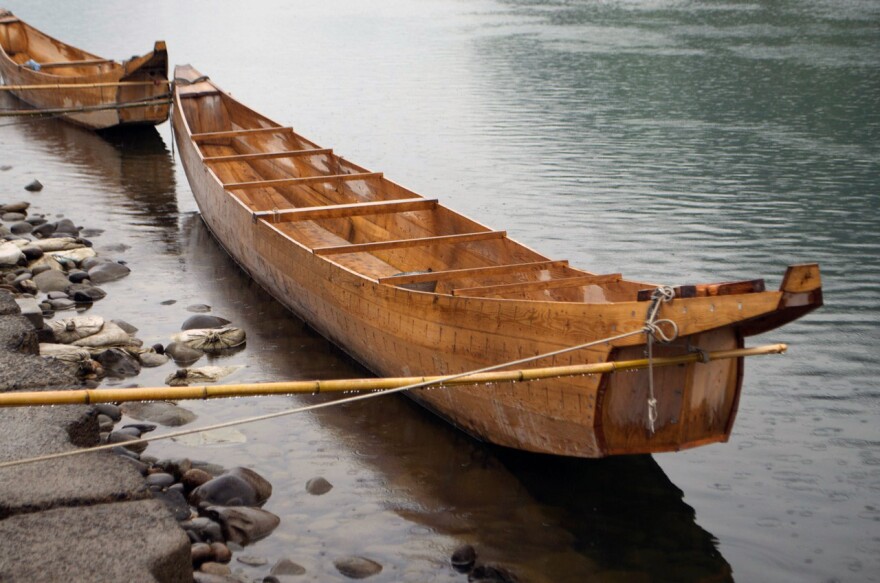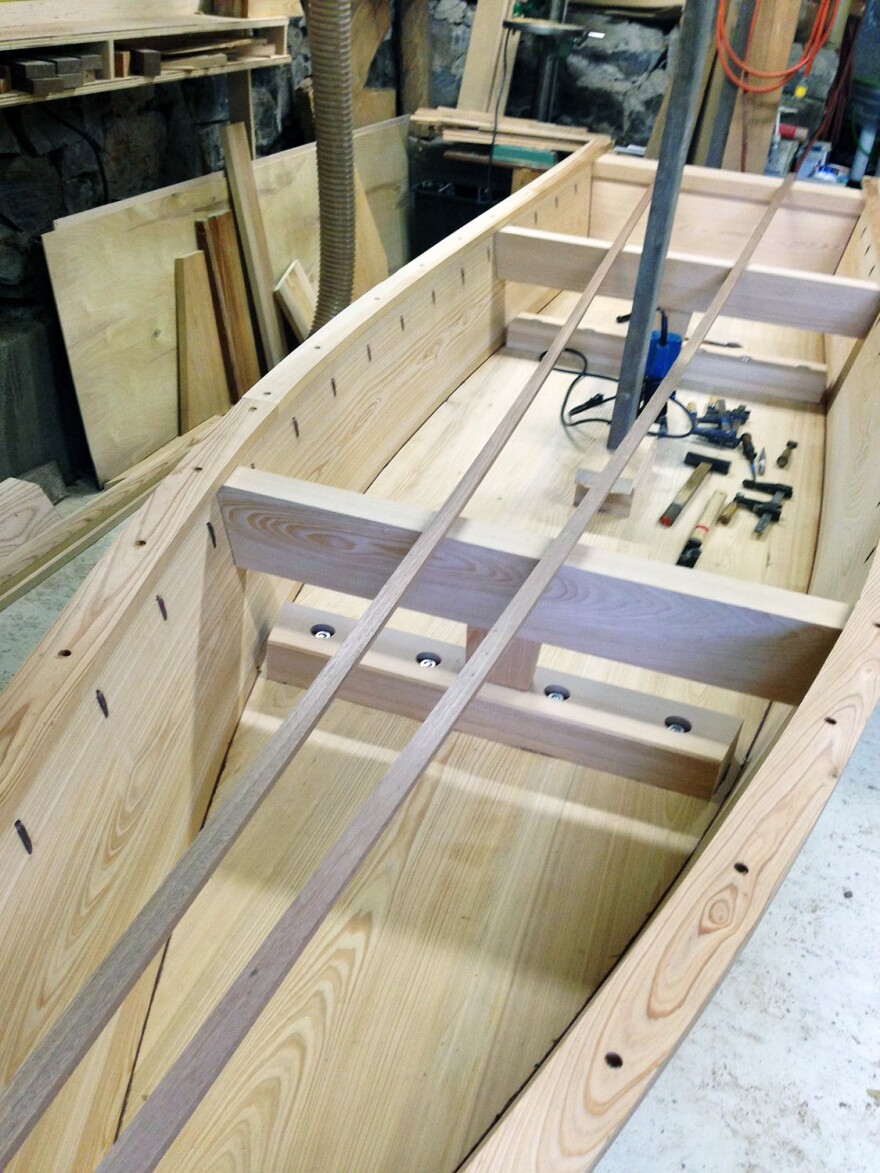The city of Vergennes has a proud history of boat building. At the base of the falls on Otter Creek, Commodore Macdonough built the ships that would defeat the British in the War of 1812. Many of the steamships that plied the waters of Lake Champlain were built there too. And now, another boat building tradition thrives in Vergennes: hand-built wooden boats, in the Japanese tradition.
"The first thing you’ll notice is the inadequate shop," Douglas Brooks says when he shows a visitor into his basement workshop. He's building a traditional Tokyo canal boat. The boat barely fits between the house support beams, and the shop is filled with Japanese saws and chisels and odd looking nails that appear to have been squashed flat.
“Here at the gunwale you see copper nails, and these are made of flat copper stock," Brooks says. "And so you see how these nails come through the rub rail, pass through the planking and then are bent over, folded over on the inside of the boat.”

Brooks has dedicated himself to learning and teaching the skills of Japanese boat building. It’s a craft he fears is dying out:
“I’ve met over 50 traditional boat builders in Japan in the course of my travels there. The youngest boat builder I know is just over 80 years old.”
Now, you might imagine that a boat – especially a wooden boat – would need some caulking, or glue to keep the water out. But not a Japanese boat.
“By repeatedly running, passing a saw between the planks, they get an absolute watertight fit," Brooks explains. "It’s really quite remarkable. And in the Japanese tradition, to have the boat even leak a drop upon launching is a huge loss of face.”
Those special flat nails require holes pre-cut by chisels. Brooks' tool of choice is called a Tsuba-nomi, which means hilt chisel.
"The reason for that is that when you pound this into the wood, you have to have something to hit to pound it back out of the wood,”he says. "This chisel is well worn, you see.”
Brooks says the boat he's working on is "as simple as it gets. It’s got a perfectly flat bottom, and then just two side planks. But in general, Japanese boats have very little internal framing, so the planking creates the structure.”
"The youngest boat builder I know is just over 80 years old." - Boat builder Douglas Brooks
Among some boat builders, its tradition to play a rhythm while pounding in the nails.
"Only one of my teachers did this, so I’m not very accomplished at it," Brook says, but he gives it a try.
Brooks was already a wooden boat builder when he went to Japan the first time as a tourist. He was amazed by the craftsmanship of boats he saw there, but also "really shocked" by the master-apprentice relationship that defined the culture of the craft.

"All the boat builders I met were elderly, none of them had apprentices, and it was obvious that the craft was doomed to disappear," he says.
Brooks has since returned to Japan many times to study boat building.
“And I’ve had five apprenticeships in Japan, and for all five craftsmen I’m their only apprentice.”
Brooks thinks traditional crafts actually survived longer in Japan than they did in the U.S., because of World War II.
“The country was totally destroyed, utterly devastated," he says. "And so … one more generation of young people were forced to do the work their fathers did.”
But that generation is now getting on in years, and when their children were young, they saw the economic prospects in Japan improving.
“In fact, many of my teachers said, 'I didn’t encourage my sons to come into the boat shop. I could see that the writing was on the wall,'" Brooks says.
Another problem was the nature of the apprenticeship process itself:
“The average boat building apprenticeship in Japan was six years. And you were probably not paid. You know, we tend to say, 'Wait, if it’s a struggle, it’s bad. Learning should be fun.' I can’t think of a more ridiculous sounding phrase to a Japanese craftsman than the notion that learning should be fun.”
"I can't think of a more ridiculous sounding phrase to a Japanese craftsman than the notion that learning should be fun."
Still, Brooks has a great deal of respect for the relationship between master and student.
“My first apprenticeship I barely spoke any Japanese," he recalls. "And it didn’t matter. Because my teacher didn’t say anything to me. It was all about, I had to watch him, and watch him and watch him. And the moment he stood up and handed me the tools and told me to sit down and go to work, I was expected to be able to do it and do it correctly. Without a doubt the most powerful educational experiences of my life happened in Japan.”
But perhaps because the skills are so hard-won, there is an element of secrecy embedded into the craft, "to the point where boat builders who made drawings of their boats intentionally left them incomplete. And often even apprentices were not taught everything by their masters," Brooks says.

Brooks now spends all of his time trying to preserve the knowledge of the last few remaining Japanese boat builders.
“These were phenomenal craftsmen who don’t write anything down. They don’t leave anything behind …except patterns you can’t understand, and drawings you can’t interpret.”
Brooks is currently raising money to preserve the craftsmanship of the last boat builder still alive on the Japanese coastline hit hardest by the 2011 tsunami.
“That coastline that got hit was [home to] the greatest concentration of wooden boats in all of Japan," he says. "And they say the tsunami destroyed 95 percent of the boats.”
Brooks had just returned from Japan, where one of the boats he built was launched into the water for the first time. Did the boat leak?
“To be quite honest, by the time we launched it – I had five students and all six of us took turns, by Shinto tradition, [and] poured sake on the bow and the stern of the boat, which was the local tradition for boat launching." He says. "So there was actually a significant amount of liquid already in the boat … So I don’t know. But if it leaked, it didn’t leak much.”
The boat Douglas Brooks is working on in his basement – once he figures out how to get it out – will find a home in a pond in a Japanese garden in Illinois.
Last winter Douglas Brooks won the prestigious Rare Craft Fellowship from the American Craft Council- honoring "those who practice a rare craft and seek to preserve the skills of their trade." He will speak at Middlebury College on Thursday, Oct. 23 at 4:30 p.m. in the Robert A. Jones '59 House.






